The Concept of Ocean Sustainability in Formal Education—Comparative Ocean Literacy Coverage Analysis of the Educational Standards of India and the USA
Abstract
1. Introduction
2. Purpose of the Study
2.1. Marine Education (ME)
2.2. Ocean Literacy (OL)
2.3. Next Generation Science Standards (USA)
3. Methodology
3.1. Research Method
3.2. Conceptual Framework
3.3. Sample Selection Description
3.3.1. OL Standards
3.3.2. Next Generation Science Standards (NGSS)
- Disciplinary core ideas (DCI);
- Science and engineering practices;
- Crosscutting concepts.
3.3.3. Document Selection for Analysis
3.4. Analysis Procedure
4. Results
4.1. Analysis of the Next Generation Science Standards (USA)
4.1.1. Band-Wise OL Alignment in NGSS
4.1.2. OL Principles Emphasized in NGSS
4.1.3. Criteria-Wise OL Alignment in NGSS
4.1.4. OL Alignment in Multiple Subjects/Disciplines (NGSS)
4.2. Analysis of the Indian National Standards (INSs)
4.2.1. Band-Wise OL Alignment in INSs
4.2.2. OL Principles Emphasized in INSs
4.2.3. Criteria-Wise OL Alignment in INSs
4.2.4. OL Alignment in Multiple Subjects (INSs)
4.3. Comparative Analysis of Educational Standards of the USA and India
4.3.1. Comparative Analysis of OL Mean Coverage (USA and India)
4.3.2. Comparative Analysis of OL Alignment across Grade Bands (USA and India)
4.3.3. Comparative Analysis of OL Principle Coverage (USA and India)
5. Discussion and Conclusions
5.1. Research Findings and Discussion
- (a)
- It was observed that the educational standards representing the USA, i.e., NGSS, covered an average of 18.7 OL fundamental concepts from grade I to grade XII. It was found that out of the two disciplines under consideration, ESS encompasses more OL concepts than LS. Furthermore, almost 70% of all concepts covered were direct in NGSS. Out of the three grade bands, the high school band had the highest OL concept alignment. Moreover, among the essential OL principles, principles 5 and 6 had maximum OL alignment in NGSS, whereas principle 7 and its concepts were minimally addressed. As per the mean coverage value, the USA received a national OL grade of “B”. From the research findings and previous related work, it can be stated that the inclusion of fundamental OL concepts in NGSS is relatively higher than the OL coverage mean value of the USA state standards. However, NGSS have ample scope to improve the national OL grade by adequately alignment with fundamental OL concepts.
- (b)
- The national educational standards of India, i.e., INSs for school instruction, received a national OL grade of “D. This implies that INSs do not sufficiently address OL alignment with a mean value 11.3. Furthermore, the study revealed that geography, a discipline of SS, had better alignment than science across all grade band levels. Like NGSS, the educational standards of the high school band had considerable OL concept alignment. OL alignment significantly rose across the grade bands in INSs. Of the total coverage, 50% of the concepts were directly addressed. Like for NGSS, OL principles 6 and 7 were highly and minimally emphasized in the INSs, respectively. Following principle 6, principle 1 was emphasized in INSs.
- (c)
- The educational standards of the USA and India were compared on various parameters, such as mean OL coverage value, grade band comparison, OL principal coverage, and nature of the coverage. It was observed that the OL mean coverage value of the USA is significantly greater than that of India, indicating that the USA more successfully encompasses OL concepts than India does by a value of 7.3. Many differences and similarities were observed between the USA and India concerning OL alignment. It was found that of the aligned concepts, the majority of them belonged to index topics of principal 6 for both countries. Furthermore, it was observed that the coverage nature of the total coverage concepts remained direct for both countries under comparison. Alignment of OL coverage remained almost stable with a minor rise in OL alignment number across all grade band levels in the USA. At the same time, a substantial progressive increase was observed across the grade band levels of India.
5.2. Conclusions
Author Contributions
Funding
Institutional Review Board Statement
Informed Consent Statement
Data Availability Statement
Conflicts of Interest
References
- Cava, F.; Schoedinger, S.; Strang, C.; Tuddenham, P. Science Content and Standards for Ocean Literacy: A Report on Ocean Literacy; College of Exploration: Berkeley, CA, USA, 2005. [Google Scholar]
- Goldar, B.; Banerjee, N. Impact of informal regulation of pollution on water quality in rivers in India. J. Environ. Manag. 2004, 73, 117–130. [Google Scholar] [CrossRef]
- Bhatnagar, A.; Devi, P.; George, M.P. Impact of Mass Bathing and Religious Activities on Water Quality Index of Prominent Water Bodies: A Multilocation Study in Haryana, India. Int. J. Ecol. 2016, 2016, 1–8. [Google Scholar] [CrossRef]
- Reddy, M.S.; Char, N.V.V. Management of lakes in India. Lakes Reserv. Res. Manag. 2006, 11, 227–237. [Google Scholar] [CrossRef]
- Qasim, S.Z.; Gupta, R.S.; Kureishi, T.W. Pollution of the seas around India. Proc. Anim. Sci. 1988, 97, 117–131. [Google Scholar] [CrossRef]
- Naja, M.; Chand, D.; Sahu, L.; Lal, S. Trace Gases Over Marine Regions around India. Indian J. Mar. Sci. 2004, 33, 95–106. [Google Scholar]
- Steel, B.S.; Smith, C.; Opsommer, L.; Curiel, S.; Warner-Steel, R. Public ocean literacy in the United States. Ocean Coast. Manag. 2005, 48, 97–114. [Google Scholar] [CrossRef]
- Picker, L. What Is Marine Education? Sci. Child. 1980, 18, 10–11. [Google Scholar]
- Donert, K.; Fauville, G.; Gotensparre, S.; Mäkitalo, Å.; Van Medegael, L.; Zwartjes, L. Review of Marine Formal Education; EU Sea Chang Project: Plymouth, UK, 2015. [Google Scholar]
- Hawthorne, M.; Alabaster, T. Citizen 2000: Development of a model of environmental citizenship. Glob. Environ. Chang. 1999, 9, 25–43. [Google Scholar] [CrossRef]
- Pruitt, S.L. The Next Generation Science Standards: The Features and Challenges. J. Sci. Teach. Educ. 2014, 25, 145–156. [Google Scholar] [CrossRef]
- Cheney, G.R.; Ruzzi, B.B.; Muralidharan, K. A Profile of the Indian Education System; National Center on Education and the Economy: Rochester, NY, USA, 2005. [Google Scholar]
- British Council. Indian School Education System: An Overview; British Council: London, UK, 2014. [Google Scholar]
- Almeida, S.; Cutter-Mackenzie, A. The Historical, Present and Futurenessof Environmental Education in India. Aust. J. Environ. Educ. 2011, 27, 122–133. [Google Scholar] [CrossRef]
- Mokos, M.; Realdon, G.; Čižmek, I.Z. How to Increase Ocean Literacy for Future Ocean Sustainability? The Influence of Non-Formal Marine Science Education. Sustainability 2020, 12, 10647. [Google Scholar] [CrossRef]
- García-González, J.A.; Palencia, S.G.; Ondoño, I.S. Characterization of Environmental Education in Spanish Geography Textbooks. Sustainability 2021, 13, 1159. [Google Scholar] [CrossRef]
- Klopfer, L.E.; Fortner, R.; Wildman, T.M. Marine education: Progress and promise. Sci. Educ. 1980, 64, 717–723. [Google Scholar] [CrossRef]
- Fortner, R.W. Abstracts of Research in Marine and Aquatic Education 1975–1990; Ohio State University, Ohio Sea Grant College Program: Columbus, OH, USA, 1991. [Google Scholar]
- Movies, A.; Boubonari, T.; Markos, A.; Kevrekidis, T. Greek Pre-Service Teachers’ Knowledge of Ocean Sciences Issues and Attitudes Toward Ocean Stewardship. J. Environ. Educ. 2015, 46, 251–270. [Google Scholar] [CrossRef]
- Plans, B.J.; Marrero, M.E. Recent ocean literacy research in United States public schools: Results and implications. Int. Electron. J. Environ. Educ. 2010, 1, 21–51. [Google Scholar]
- Schoedinger, S.; Tran, L.U.; Whitley, L. From the principles to the scope and sequence: A brief history of the ocean literacy campaign. NMEA Spec. Rep. 2010, 3, 3–7. [Google Scholar]
- Guest, H.; Lotze, H.K.; Wallace, D. Youth and the sea: Ocean literacy in Nova Scotia, Canada. Mar. Policy 2015, 58, 98–107. [Google Scholar] [CrossRef]
- Hoffman, M.; Barstow, D. Revolutionizing Earth System Science Education for the 21st Century: Report and Recommendations from a 50-State Analysis of Earth Science Education Standards; National Oceanic and Atmospheric Administration: Washington, DC, USA, 2007.
- Greely, T. Ocean Literacy and Reasoning about Ocean Issues: The Influence of Content, Experience and Morality; University of South Florida: Tampa, FL, USA, 2008. [Google Scholar]
- Bybee, R.W. NGSS and the Next Generation of Science Teachers. J. Sci. Teach. Educ. 2014, 25, 211–221. [Google Scholar] [CrossRef]
- States. NGSS—The Three Dimensions OF Science Learning. 2013. Available online: https://www.nextgenscience.org/ (accessed on 1 August 2020).
- NCERT. Environmental Education as Infused in NCERT Syllabus for Classes I to XII as Per NCF 2005. 2005. Available online: http://ncert.nic.in/book_publishing/environ_edu/eei.pdf (accessed on 1 August 2020).
- Yilmaz, K. Comparison of quantitative and qualitative research traditions: Epistemological, theoretical, and methodological differences. Eur. J. Educ. 2013, 48, 311–325. [Google Scholar] [CrossRef]
- Patton, M.Q. Qualitative research. Encycl. Stat. Behav. Sci. 2005. [Google Scholar] [CrossRef]
- Stemler, S. An overview of content analysis. Pract. Assess. Res. Eval. 2000, 7, 17. [Google Scholar]
- Clark-Carter, D. Quantitative Psychological Research: The Complete Student’s Companion; Routledge: London, UK, 2018. [Google Scholar]
- Kaur, H. Technology Transforming Mathematics Education. Int. J. Adv. Res. Comput. Sci. 2016, 7, 246–249. [Google Scholar]
- Banerjee, B.K.; Stöber, G. Living in Harmony? “Casteism”, Communalism, and Regionalism in Indian Social Science Textbooks. J. Educ. Media Mem. Soc. 2014, 6, 42–86. [Google Scholar]
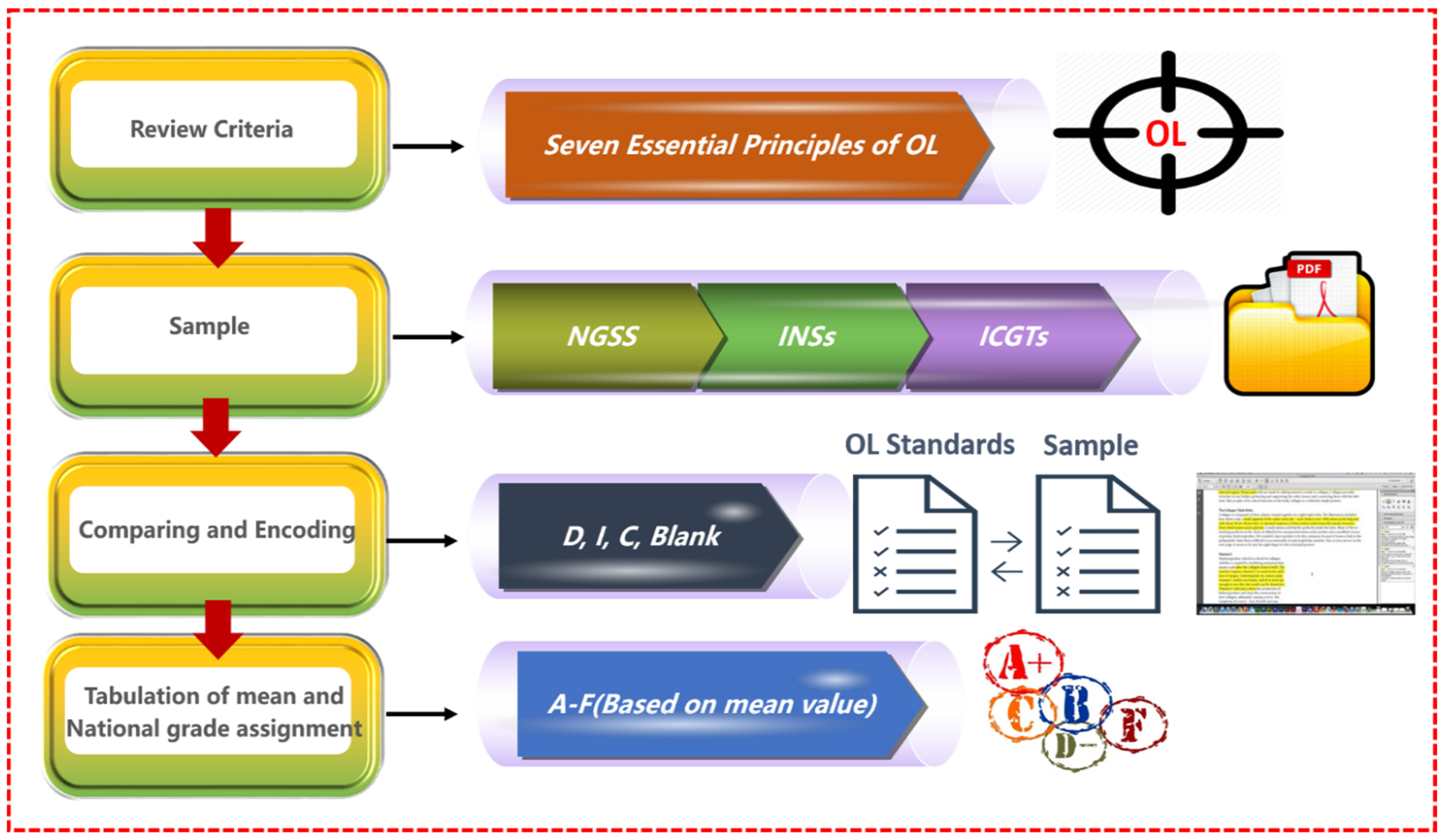


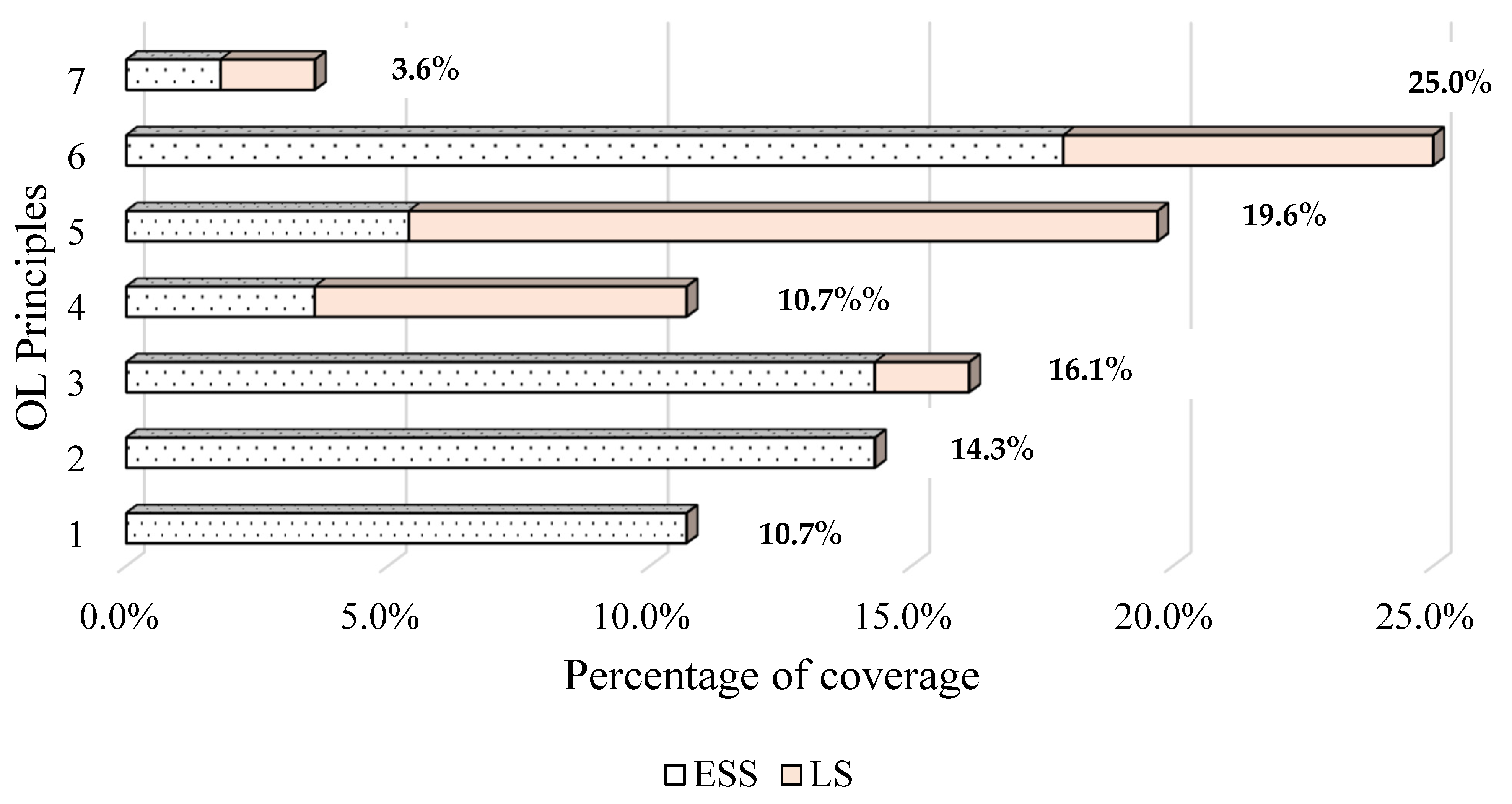
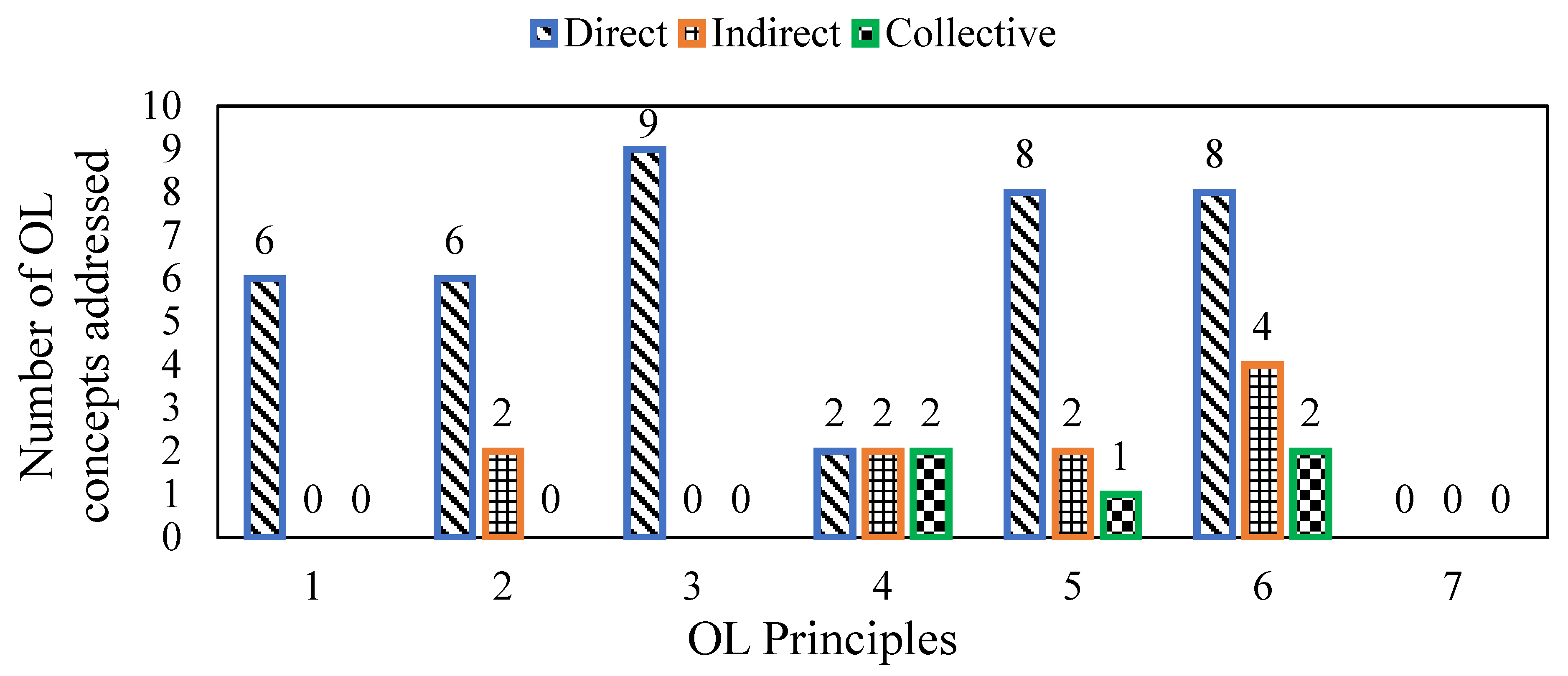

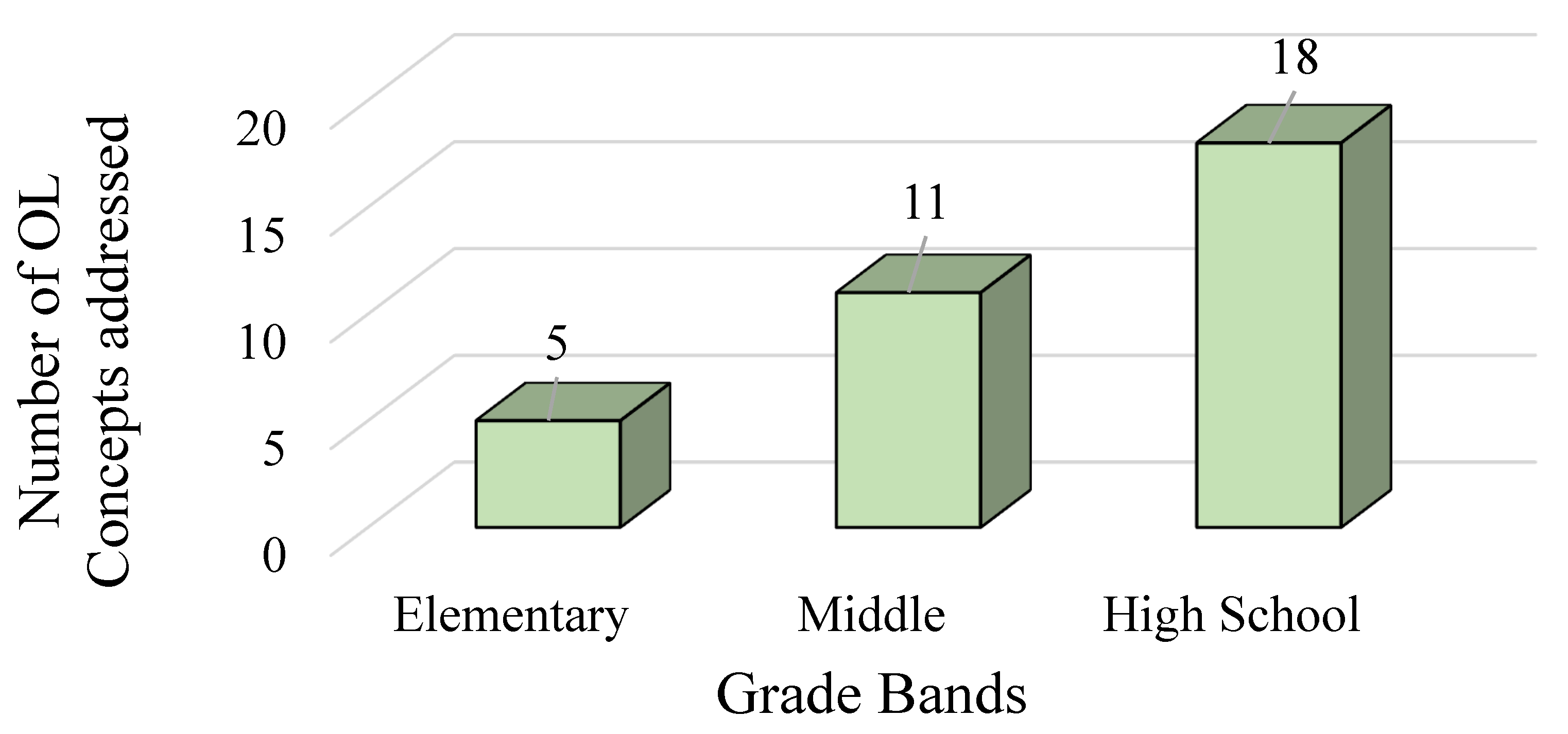

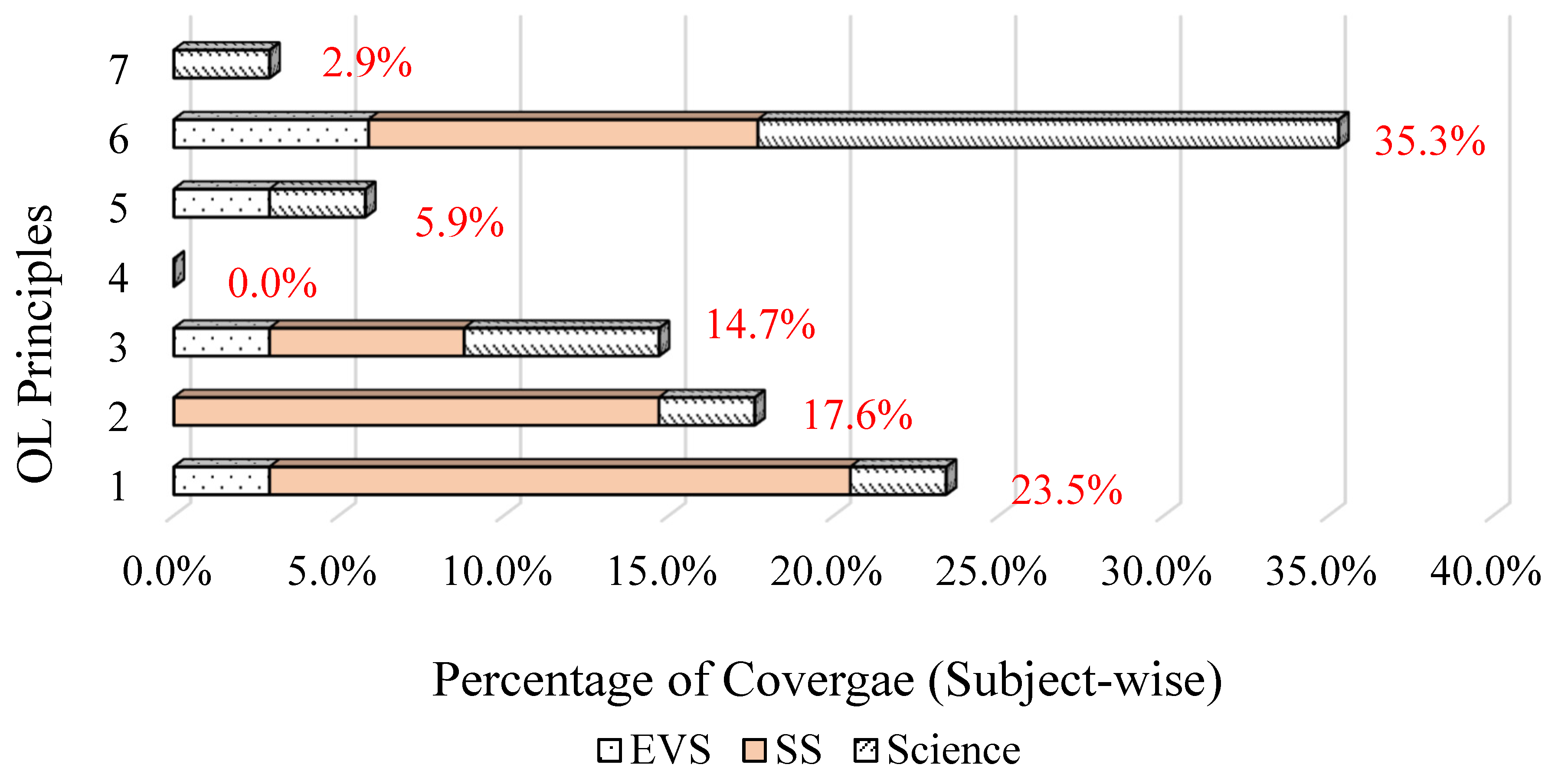
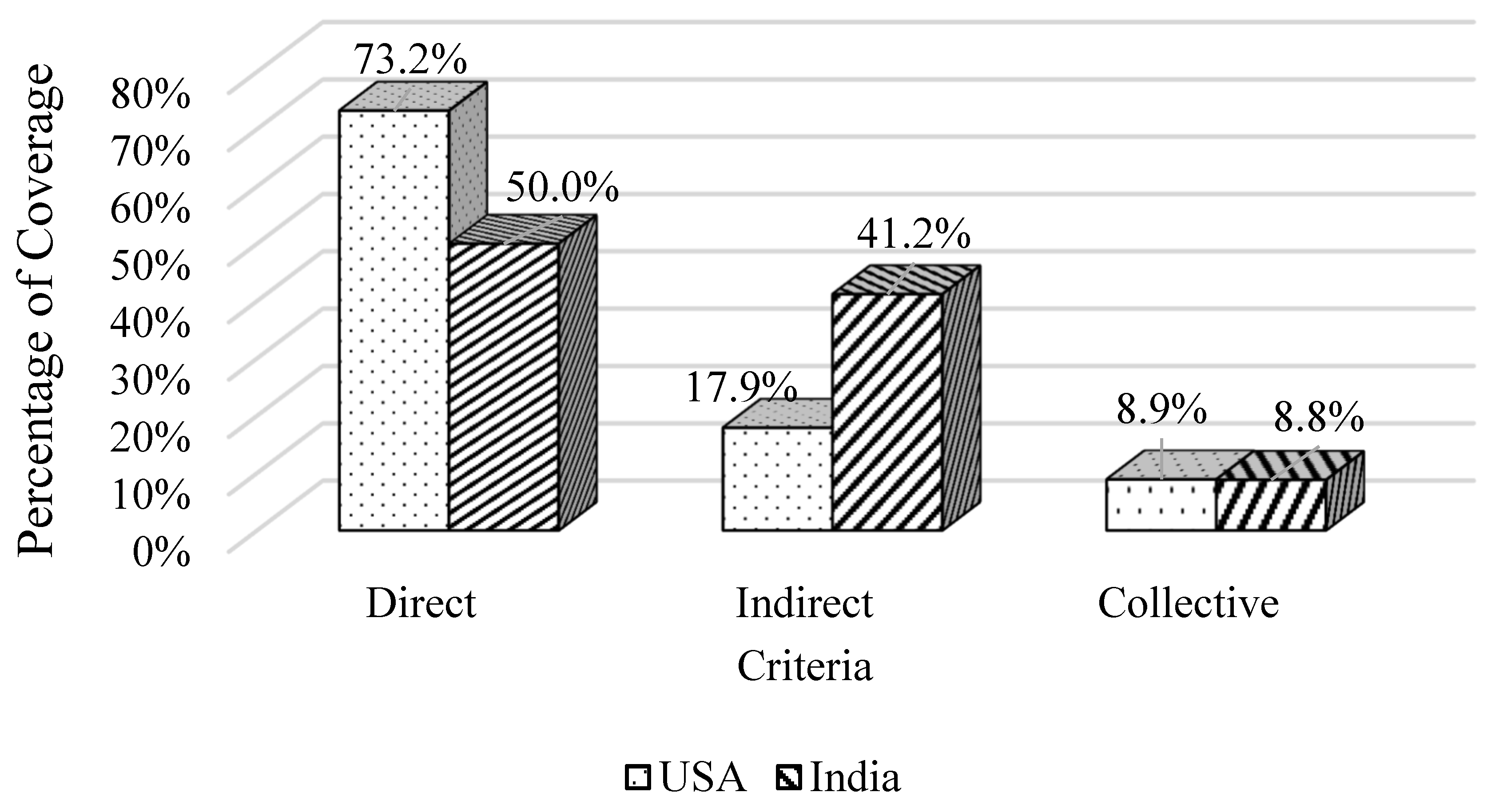




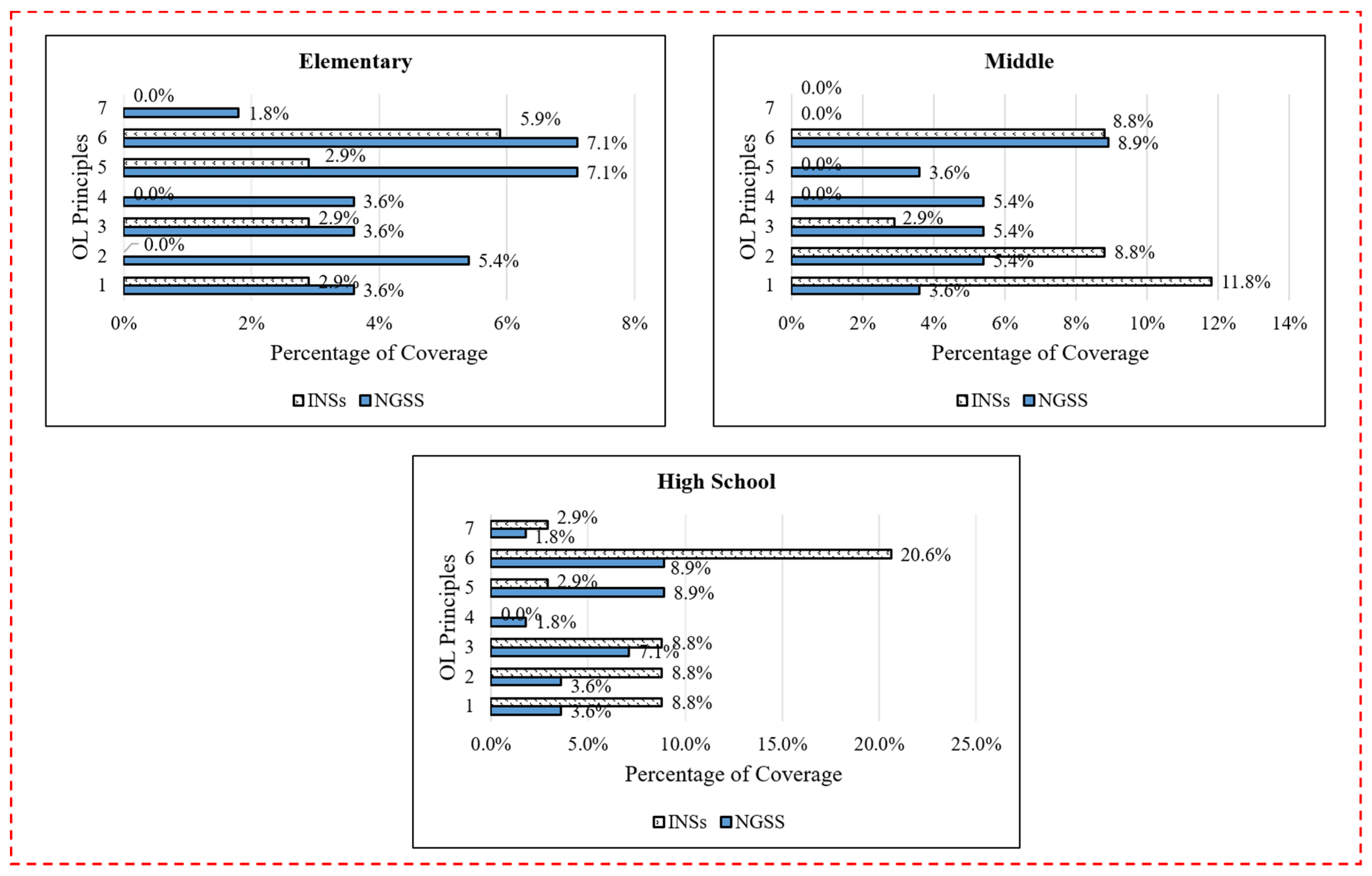
| Sr. No. | The Seven Essential Principles of Ocean Literacy |
|---|---|
| 1 | The earth has one big ocean with many features. |
| 2 | The ocean and life in the ocean shape the features of the earth. |
| 3 | The ocean has a significant influence on weather and climate. |
| 4 | The ocean makes the earth habitable. |
| 5 | The ocean supports a great diversity of life and ecosystems. |
| 6 | The ocean and humans are inextricably interconnected. |
| 7 | The ocean is largely unexplored. |
| Rating | Measure |
|---|---|
| Directly (D) | Standards or content directly mention two or more major components of the specific review criteria. |
| Indirectly (I) | Standards or content indirectly mention or closely refer to one or more components of the specific review criteria. |
| Collective (C) | The collective representation of direct and indirect conditions. |
| Blank | Standards or content fail to address the concepts of review criteria. |
| Number of Fundamental Concepts Directly, Indirectly, or Collectively Addressed in Sample (Real Limits) | Grade |
|---|---|
| 30–25 | A |
| 24–19 | B |
| 18–13 | C |
| 12–7 | D |
| 6–1 | F |
| Number of Fundamental Concepts Directly, Indirectly, or Collectively Addressed in Sample (Real Limits) | Number of Fundamental Concepts Directly, Indirectly, or Collectively Addressed in Sample (Apparent Limits) | Grade |
|---|---|---|
| 30–25 | 30–24.6 | A |
| 24–19 | 24.5–18.6 | B |
| 18–13 | 18.5–12.6 | C |
| 12–7 | 12.5–6.6 | D |
| 6–1 | 6.5–1 | F |
| Essential Ocean Literacy Principles | Type of Concept Representation | Index Topics | |||||||
|---|---|---|---|---|---|---|---|---|---|
| Grade Bands | Total | Direct | Indirect | Collective | 1 | 1 | 1 | 1 | |
| (A) | (B) | (C) | (D) | ||||||
| Principle 1 | I–V (ESS) | 2 | 2 | 0 | 0 | D | D | ||
| I–V (LS) | 0 | 0 | 0 | 0 | |||||
| I–V | 2 | 2 | 0 | ||||||
| VI–VIII (ESS) | 2 | 2 | 0 | 0 | D | D | |||
| VI–VIII | 0 | 0 | 0 | 0 | |||||
| (LS) | |||||||||
| VI–VIII | 2 | 2 | 0 | 0 | |||||
| IX–XII(ESS) | 2 | 2 | 0 | 0 | D | D | |||
| IX–XII | 0 | 0 | 0 | 0 | |||||
| (LS) | |||||||||
| IX–XII | 2 | 2 | 0 | 0 | |||||
| Total | 6 | 6 | 0 | 0 | |||||
| Essential Ocean Literacy Principles | Type of Concept Representation | Index Topics | |||||||
|---|---|---|---|---|---|---|---|---|---|
| Grade Bands | Total | Direct | Indirect | Collective | 2 (A) | 2 (B) | 2 (C) | 2 (D) | |
| Principle 2 | I–V (ESS) | 3 | 2 | 1 | 0 | D | D | I | |
| I–V (LS) | 0 | 0 | 0 | 0 | |||||
| I–V | 3 | 2 | 1 | ||||||
| VI–VIII (ESS) | 3 | 2 | 1 | 0 | D | D | I | ||
| VI–VIII | 0 | 0 | 0 | 0 | |||||
| (LS) | |||||||||
| VI–VIII | 3 | 2 | 1 | 0 | |||||
| IX–XII(ESS) | 2 | 2 | 0 | 0 | D | D | |||
| IX–XII | 0 | 0 | 0 | 0 | |||||
| (LS) | |||||||||
| IX–XII | 2 | 2 | 0 | 0 | |||||
| Total | 8 | 6 | 2 | 0 | |||||
| Essential Ocean Literacy Principles | Type of Concept Representation | Index Topics | |||||||
|---|---|---|---|---|---|---|---|---|---|
| Grade Bands | Total | Direct | Indirect | Collective | 3 (A) | 3 (B) | 3 (C) | 3 (D) | |
| Principle 3 | I–V (ESS) | 2 | 2 | 0 | 0 | D | D | ||
| I–V (LS) | 0 | 0 | 0 | 0 | |||||
| I–V | 2 | 2 | 0 | 0 | |||||
| VI–VIII (ESS) | 3 | 3 | 0 | 0 | D | D | D | ||
| VI–VIII | 0 | 0 | 0 | 0 | |||||
| (LS) | |||||||||
| VI–VIII | 3 | 3 | 0 | 0 | |||||
| IX–XII(ESS) | 3 | 3 | 0 | 0 | D | D | D | ||
| IX–XII | 1 | 1 | 0 | 0 | D | ||||
| (LS) | |||||||||
| IX–XII | 4 | 4 | 0 | 0 | |||||
| Total | 9 | 9 | 0 | 0 | |||||
| Essential Ocean Literacy Principles | Type of Concept Representation | Index Topics | |||||
|---|---|---|---|---|---|---|---|
| Grade Bands | Total | Direct | Indirect | Collective | 4 (A) | 4 (B) | |
| Principle 4 | I–V (ESS) | 1 | 1 | 0 | 0 | D | |
| I–V (LS) | 1 | 0 | 0 | 1 | C | ||
| I–V | 2 | 1 | 0 | 1 | |||
| VI–VIII (ESS) | 1 | 0 | 1 | 0 | I | ||
| VI–VIII | 2 | 1 | 1 | 0 | I | D | |
| (LS) | |||||||
| VI–VIII | 3 | 1 | 2 | 0 | |||
| IX–XII(ESS) | 0 | 0 | 0 | 0 | |||
| IX–XII | 1 | 0 | 0 | 1 | C | ||
| (LS) | |||||||
| IX–XII | 1 | 0 | 0 | 1 | |||
| Total | 6 | 2 | 2 | 2 | |||
| Essential Ocean Literacy Principles | Type of Concept Representation | Index Topics | ||||||||||
|---|---|---|---|---|---|---|---|---|---|---|---|---|
| Grade Bands | Total | Direct | Indirect | Collective | 5 (A) | 5 (B) | 5 (C) | 5 (D) | 5 (E) | 5 (F) | 5 (G) | |
| Principle 5 | I–V (ESS) | 1 | 0 | 0 | 1 | C | ||||||
| I–V (LS) | 3 | 2 | 1 | 0 | D | D | I | |||||
| I–V | 4 | 2 | 1 | 1 | ||||||||
| VI–VIII (ESS) | 0 | 0 | 0 | 0 | ||||||||
| VI–VIII (LS) | 2 | 2 | 0 | 0 | D | D | ||||||
| VI–VIII | 2 | 2 | 0 | 0 | ||||||||
| IX–XII (ESS) | 2 | 1 | 1 | 0 | D | I | ||||||
| IX–XII (LSS) | 3 | 3 | 0 | 0 | D | D | D | |||||
| IX–XII | 5 | 4 | 1 | 0 | ||||||||
| Total | 11 | 8 | 2 | 1 | ||||||||
| Essential Ocean Literacy Principles | Type of Concept Representation | Index Topics | ||||||||
|---|---|---|---|---|---|---|---|---|---|---|
| Grade Bands | Total | Direct | Indirect | Collective | 6 (A) | 6 (B) | 6 (C) | 6 (D) | 6 (E) | |
| Principal 6 | I–V (ESS) | 4 | 1 | 1 | 2 | C | C | D | I | |
| I–V (LS) | 0 | 0 | 0 | 0 | ||||||
| I–V | 4 | 1 | 1 | 2 | ||||||
| VI–VIII (ESS) | 3 | 2 | 1 | 0 | D | I | D | |||
| VI–VIII | 2 | 0 | 2 | 0 | I | I | ||||
| (LS) | ||||||||||
| VI–VIII | 5 | 2 | 3 | 0 | ||||||
| IX–XII(ESS) | 3 | 3 | 0 | 0 | D | D | D | |||
| IX–XII | 2 | 2 | 0 | 0 | D | D | ||||
| (LS) | ||||||||||
| IX–XII | 5 | 5 | 0 | 0 | ||||||
| Total | 14 | 8 | 4 | 2 | ||||||
| Essential Ocean Literacy Principles | Type of Concept Representation | Index Topics | |||||||
|---|---|---|---|---|---|---|---|---|---|
| Grade Bands | Total | Direct | Indirect | Collective | 7 (A) | 7 (B) | 7 (C) | 7 (D) | |
| Principle 7 | I–V (ESS) | 1 | 1 | 0 | 0 | D | |||
| I–V (LS) | 0 | 0 | 0 | 0 | |||||
| I–V | 1 | 1 | 0 | 0 | |||||
| VI–VIII (ESS) | 0 | 0 | 0 | 0 | |||||
| VI–VIII | 0 | 0 | 0 | 0 | |||||
| (LS) | |||||||||
| VI–VIII | 0 | 0 | 0 | 0 | |||||
| IX–XII(ESS) | 0 | 0 | 0 | 0 | |||||
| IX–XII | 1 | 1 | 0 | 0 | D | ||||
| (LS) | |||||||||
| IX–XII | 1 | 1 | 0 | 0 | |||||
| Total | 2 | 2 | 0 | 0 | |||||
| Essential Ocean Literacy Principles | Type of Concept Representation | Index Topics | |||||||
|---|---|---|---|---|---|---|---|---|---|
| Grade Bands | Total | Direct | Indirect | Collective | 1 | 1 | 1 | 1 | |
| (A) | (B) | (C) | (D) | ||||||
| Principle 1 | I–V | 1 | 1 | 0 | 0 | D | |||
| VI–VIII(SS) | 3 | 3 | 0 | 0 | D | D | D | ||
| VI–VIII | 1 | 0 | 1 | 0 | I | ||||
| (Science) | |||||||||
| VI–VIII | 4 | 3 | 1 | 0 | |||||
| IX–XII(SS) | 3 | 2 | 1 | 0 | I | D | D | ||
| IX–XII | 0 | 0 | 0 | 0 | |||||
| (Science) | |||||||||
| IX–XII | 3 | 2 | 1 | 0 | |||||
| Total | 8 | 6 | 2 | 0 | |||||
| Essential Ocean Literacy Principles | Type of Concept Representation | Index Topics | |||||||
|---|---|---|---|---|---|---|---|---|---|
| Grade Bands | Total | Direct | Indirect | Collective | 2 (A) | 2 (B) | 2 (C) | 2 (D) | |
| Principle 2 | I–V | 0 | 0 | 0 | 0 | ||||
| VI–VIII(SS) | 2 | 1 | 0 | 1 | C | D | |||
| VI–VIII (Science) | 1 | 1 | 0 | 0 | D | ||||
| VI–VIII | 3 | 2 | 0 | 1 | |||||
| IX–XII(SS) | 3 | 2 | 1 | 0 | I | D | D | ||
| IX–XII (Science) | 0 | 0 | 0 | 0 | |||||
| IX–XII | 3 | 2 | 1 | 0 | |||||
| Total | 6 | 4 | 1 | 1 | |||||
| Essential Ocean Literacy Principles | Type of Concept Representation | Index Topics | |||||||
|---|---|---|---|---|---|---|---|---|---|
| Grade Bands | Total | Direct | Indirect | Collective | 3 (A) | 3 (B) | 3 (C) | 3 (D) | |
| I–V | 1 | 1 | 0 | 0 | D | ||||
| VI–VIII(SS) | 0 | 0 | 0 | 0 | |||||
| VI–VIII | 1 | 1 | 0 | 0 | D | ||||
| (Science) | |||||||||
| Principle 3 | VI–VIII | 1 | 1 | 0 | 0 | ||||
| IX–XII(SS) | 2 | 1 | 0 | 1 | C | D | |||
| IX–XII | 1 | 0 | 1 | 0 | I | ||||
| (Science) | |||||||||
| IX–XII | 3 | 1 | 1 | 1 | |||||
| Total | 5 | 3 | 1 | 1 | |||||
| Essential Ocean Literacy Principles | Type of Concept Representation | Index Topics | |||||
|---|---|---|---|---|---|---|---|
| Grade Bands | Total | Direct | Indirect | Collective | 4 (A) | 4 (B) | |
| Principle 4 | I–V | 0 | 0 | 0 | 0 | ||
| VI–VIII(SS) | 0 | 0 | 0 | 0 | |||
| VI–VIII | 0 | 0 | 0 | 0 | |||
| (Science) | |||||||
| VI–VIII | 0 | 0 | 0 | 0 | |||
| IX–XII(SS) | 0 | 0 | 0 | 0 | |||
| IX–XII | 1 | 0 | 1 | 0 | |||
| (Science) | |||||||
| IX–XII | 0 | 0 | 0 | 0 | |||
| Total | 0 | 0 | 0 | 0 | |||
| Essential Ocean Literacy Principles | Type of Concept Representation | Index Topics | ||||||||||
|---|---|---|---|---|---|---|---|---|---|---|---|---|
| Grade Bands | Total | Direct | Indirect | Collective | 5 (A) | 5 (B) | 5 (C) | 5 (D) | 5 (E) | 5 (F) | 5 (G) | |
| I–V | 1 | 0 | 1 | 0 | I | |||||||
| VI–VIII(SS) | 0 | 0 | 0 | 0 | ||||||||
| VI–VIII | 0 | 0 | 0 | 0 | ||||||||
| Principle 5 | (Science) | |||||||||||
| VI–VIII | 0 | 0 | 0 | 0 | ||||||||
| IX–XII(SS) | 0 | 0 | 0 | 0 | ||||||||
| IX–XII | 1 | 0 | 1 | 0 | I | |||||||
| (Science) | ||||||||||||
| IX–XII | 1 | 0 | 1 | 0 | ||||||||
| Total | 2 | 0 | 2 | 0 | ||||||||
| Essential Ocean Literacy Principles | Type of Concept Representation | Index Topics | ||||||||
|---|---|---|---|---|---|---|---|---|---|---|
| Grade Bands | Total | Direct | Indirect | Collective | 6 (A) | 6 (B) | 6 (C) | 6 (D) | 6 (E) | |
| I–V | 2 | 1 | 0 | 1 | D | C | ||||
| VI–VIII(SS) | 1 | 0 | 1 | 0 | I | |||||
| VI–VIII | 2 | 1 | 1 | 0 | I | D | ||||
| Principle 6 | (Science) | |||||||||
| VI–VIII | 3 | 1 | 2 | 0 | ||||||
| IX–XII(SS) | 3 | 0 | 3 | 0 | I | I | I | |||
| IX–XII | 4 | 2 | 2 | 0 | D | D | I | I | ||
| (Science) | ||||||||||
| IX–XII | 7 | 2 | 5 | 0 | ||||||
| Total | 12 | 4 | 7 | 1 | ||||||
| Essential Ocean Literacy Principles | Type of Concept Representation | Index Topics | |||||||
|---|---|---|---|---|---|---|---|---|---|
| Grade Bands | Total | Direct | Indirect | Collective | 7 (A) | 7 (B) | 7 (C) | 7 (D) | |
| I–V | 0 | 0 | 0 | 0 | |||||
| VI–VIII(SS) | 0 | 0 | 0 | 0 | |||||
| VI–VIII | 0 | 0 | 0 | 0 | |||||
| (Science) | |||||||||
| Principle 7 | VI–VIII | 0 | 0 | 0 | 0 | ||||
| IX–XII(SS) | 0 | 0 | 0 | 0 | |||||
| IX–XII | 1 | 0 | 1 | 0 | I | ||||
| (Science) | |||||||||
| IX–XII | 1 | 0 | 1 | 0 | |||||
| Total | 1 | 0 | 1 | 0 | |||||
Publisher’s Note: MDPI stays neutral with regard to jurisdictional claims in published maps and institutional affiliations. |
© 2021 by the authors. Licensee MDPI, Basel, Switzerland. This article is an open access article distributed under the terms and conditions of the Creative Commons Attribution (CC BY) license (https://creativecommons.org/licenses/by/4.0/).
Share and Cite
Chang, C.-C.; Hirenkumar, T.C.; Wu, C.-K. The Concept of Ocean Sustainability in Formal Education—Comparative Ocean Literacy Coverage Analysis of the Educational Standards of India and the USA. Sustainability 2021, 13, 4314. https://doi.org/10.3390/su13084314
Chang C-C, Hirenkumar TC, Wu C-K. The Concept of Ocean Sustainability in Formal Education—Comparative Ocean Literacy Coverage Analysis of the Educational Standards of India and the USA. Sustainability. 2021; 13(8):4314. https://doi.org/10.3390/su13084314
Chicago/Turabian StyleChang, Cheng-Chieh, Thakkar Chandni Hirenkumar, and Chin-Kuo Wu. 2021. "The Concept of Ocean Sustainability in Formal Education—Comparative Ocean Literacy Coverage Analysis of the Educational Standards of India and the USA" Sustainability 13, no. 8: 4314. https://doi.org/10.3390/su13084314
APA StyleChang, C.-C., Hirenkumar, T. C., & Wu, C.-K. (2021). The Concept of Ocean Sustainability in Formal Education—Comparative Ocean Literacy Coverage Analysis of the Educational Standards of India and the USA. Sustainability, 13(8), 4314. https://doi.org/10.3390/su13084314






